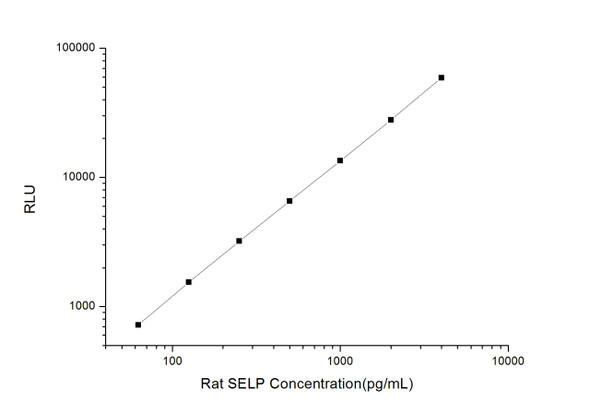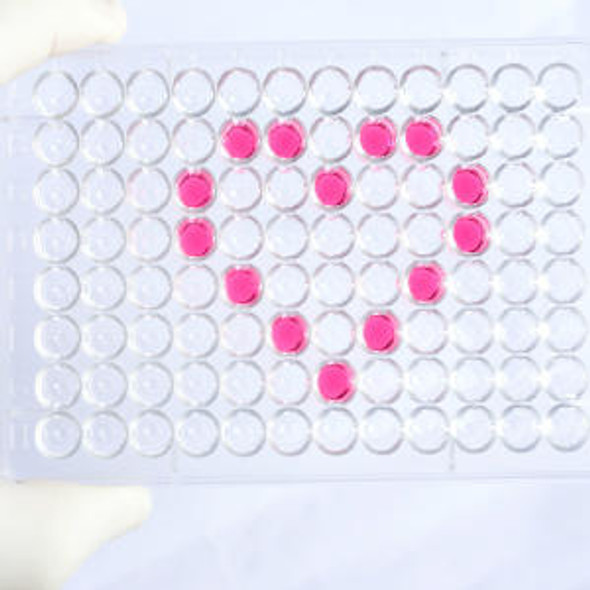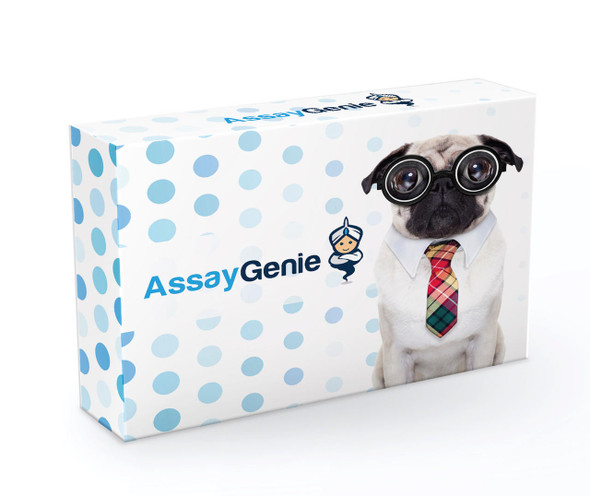Human Cell Biology ELISA Kits 3
Human SELP (P-Selectin) CLIA Kit (HUES00547)
- SKU:
- HUES00547
- Product Type:
- ELISA Kit
- ELISA Type:
- CLIA Kit
- Size:
- 96 Assays
- Sensitivity:
- 18.75pg/mL
- Range:
- 31.25-2000pg/mL
- ELISA Type:
- Sandwich
- Synonyms:
- CD62, CD62P, GMP140, GRMP, LECAM3, PADGEM, PSEL
- Reactivity:
- Human
- Sample Type:
- Serum, plasma and other biological fluids
- Research Area:
- Cell Biology
Description
| Assay type: | Sandwich |
| Format: | 96T |
| Assay time: | 4.5h |
| Reactivity: | Human |
| Detection method: | Chemiluminescence |
| Detection range: | 31.25-2000 pg/mL |
| Sensitivity: | 18.75 pg/mL |
| Sample volume: | 100µL |
| Sample type: | Serum, plasma and other biological fluids |
| Repeatability: | CV < 15% |
| Specificity: | This kit recognizes Human SELP in samples. No significant cross-reactivity or interference between Human SELP and analogues was observed. |
This kit uses Sandwich-CLIA as the method. The micro CLIA plate provided in this kit has been pre-coated with an antibody specific to Human SELP. Standards or samples are added to the appropriate micro CLIA plate wells and combined with the specific antibody. Then a biotinylated detection antibody specific for Human SELP and Avidin-Horseradish Peroxidase (HRP) conjugate are added to each micro plate well successively and incubated. Free components are washed away. The substrate solution is added to each well. Only those wells that contain Human SELP, biotinylated detection antibody and Avidin-HRP conjugate will appear fluorescence. The Relative light unit (RLU) value is measured spectrophotometrically by the Chemiluminescence immunoassay analyzer. The RLU value is positively associated with the concentration of Human SELP. The concentration of Human SELP in the samples can be calculated by comparing the RLU of the samples to the standard curve.
| UniProt Protein Function: | SELP: Ca(2+)-dependent receptor for myeloid cells that binds to carbohydrates on neutrophils and monocytes. Mediates the interaction of activated endothelial cells or platelets with leukocytes. The ligand recognized is sialyl-Lewis X. Mediates rapid rolling of leukocyte rolling over vascular surfaces during the initial steps in inflammation through interaction with PSGL1. Defects in SELP may be a cause of susceptibility to ischemic stroke (ISCHSTR); also known as cerebrovascular accident or cerebral infarction. A stroke is an acute neurologic event leading to death of neural tissue of the brain and resulting in loss of motor, sensory and/or cognitive function. Ischemic strokes, resulting from vascular occlusion, is considered to be a highly complex disease consisting of a group of heterogeneous disorders with multiple genetic and environmental risk factors. Belongs to the selectin/LECAM family. |
| UniProt Protein Details: | Protein type:Membrane protein, integral; Cell adhesion Chromosomal Location of Human Ortholog: 1q22-q25 Cellular Component: nucleoplasm; extracellular space; platelet alpha granule membrane; integral to plasma membrane; cytoplasm; plasma membrane; platelet dense granule membrane; external side of plasma membrane Molecular Function:heparin binding; protein binding; lipopolysaccharide binding; glycosphingolipid binding; glycoprotein binding; calcium-dependent protein binding; sialic acid binding; fucose binding Biological Process: platelet activation; positive regulation of leukocyte migration; response to lipopolysaccharide; defense response to Gram-negative bacterium; heterophilic cell adhesion; positive regulation of phosphoinositide 3-kinase cascade; leukocyte adhesion; platelet degranulation; regulation of integrin activation; leukocyte tethering or rolling; blood coagulation; cell adhesion; inflammatory response; leukocyte migration Disease: Ige Responsiveness, Atopic |
| NCBI Summary: | This gene encodes a 140 kDa protein that is stored in the alpha-granules of platelets and Weibel-Palade bodies of endothelial cells. This protein redistributes to the plasma membrane during platelet activation and degranulation and mediates the interaction of activated endothelial cells or platelets with leukocytes. The membrane protein is a calcium-dependent receptor that binds to sialylated forms of Lewis blood group carbohydrate antigens on neutrophils and monocytes. Alternative splice variants may occur but are not well documented. [provided by RefSeq, Jul 2008] |
| UniProt Code: | P16109 |
| NCBI GenInfo Identifier: | 215274139 |
| NCBI Gene ID: | 6403 |
| NCBI Accession: | P16109. 3 |
| UniProt Secondary Accession: | P16109,Q5R344, Q8IVD1, |
| UniProt Related Accession: | P16109 |
| Molecular Weight: | 90,834 Da |
| NCBI Full Name: | P-selectin |
| NCBI Synonym Full Names: | selectin P (granule membrane protein 140kDa, antigen CD62) |
| NCBI Official Symbol: | SELP |
| NCBI Official Synonym Symbols: | CD62; GRMP; PSEL; CD62P; GMP140; LECAM3; PADGEM |
| NCBI Protein Information: | P-selectin; GMP-140; granule membrane protein 140; granulocyte membrane protein; CD62 antigen-like family member P; platelet alpha-granule membrane protein; leukocyte-endothelial cell adhesion molecule 3; platelet activation dependent granule-external membrane protein |
| UniProt Protein Name: | P-selectin |
| UniProt Synonym Protein Names: | CD62 antigen-like family member P; Granule membrane protein 140; GMP-140; Leukocyte-endothelial cell adhesion molecule 3; LECAM3; Platelet activation dependent granule-external membrane protein; PADGEM; CD_antigen: CD62P |
| Protein Family: | P-selectin |
| UniProt Gene Name: | SELP |
| UniProt Entry Name: | LYAM3_HUMAN |
As the RLU values of the standard curve may vary according to the conditions of the actual assay performance (e. g. operator, pipetting technique, washing technique or temperature effects), the operator should establish a standard curve for each test. Typical standard curve and data is provided below for reference only.
| Concentration (pg/mL) | RLU | Average | Corrected |
| 2000 | 53281 58161 | 55721 | 55693 |
| 1000 | 21970 25978 | 23974 | 23946 |
| 500 | 11971 10093 | 11032 | 11004 |
| 250 | 5273 5315 | 5294 | 5266 |
| 125 | 2769 2447 | 2608 | 2580 |
| 62.5 | 1414 1208 | 1311 | 1283 |
| 31.25 | 654 694 | 674 | 646 |
| 0 | 28 28 | 28 | -- |
Precision
Intra-assay Precision (Precision within an assay): 3 samples with low, mid range and high level Human SELP were tested 20 times on one plate, respectively.
Inter-assay Precision (Precision between assays): 3 samples with low, mid range and high level Human SELP were tested on 3 different plates, 20 replicates in each plate.
| Intra-assay Precision | Inter-assay Precision | |||||
| Sample | 1 | 2 | 3 | 1 | 2 | 3 |
| n | 20 | 20 | 20 | 20 | 20 | 20 |
| Mean (pg/mL) | 104.81 | 237.29 | 912.71 | 110.52 | 259.31 | 912.48 |
| Standard deviation | 12.74 | 27.22 | 84.24 | 13.15 | 27.31 | 89.42 |
| C V (%) | 12.16 | 11.47 | 9.23 | 11.90 | 10.53 | 9.80 |
Recovery
The recovery of Human SELP spiked at three different levels in samples throughout the range of the assay was evaluated in various matrices.
| Sample Type | Range (%) | Average Recovery (%) |
| Serum (n=5) | 90-100 | 95 |
| EDTA plasma (n=5) | 87-102 | 93 |
| Cell culture media (n=5) | 90-105 | 98 |
Linearity
Samples were spiked with high concentrations of Human SELP and diluted with Reference Standard & Sample Diluent to produce samples with values within the range of the assay.
| Serum (n=5) | EDTA plasma (n=5) | Cell culture media (n=5) | ||
| 1:2 | Range (%) | 93-108 | 86-101 | 93-107 |
| Average (%) | 100 | 93 | 99 | |
| 1:4 | Range (%) | 92-106 | 94-107 | 98-115 |
| Average (%) | 99 | 100 | 106 | |
| 1:8 | Range (%) | 103-117 | 90-103 | 90-106 |
| Average (%) | 110 | 97 | 97 | |
| 1:16 | Range (%) | 87-100 | 97-112 | 102-118 |
| Average (%) | 94 | 102 | 108 |
An unopened kit can be stored at 4°C for 1 month. If the kit is not used within 1 month, store the items separately according to the following conditions once the kit is received.
| Item | Specifications | Storage |
| Micro CLIA Plate(Dismountable) | 8 wells ×12 strips | -20°C, 6 months |
| Reference Standard | 2 vials | |
| Concentrated Biotinylated Detection Ab (100×) | 1 vial, 120 µL | |
| Concentrated HRP Conjugate (100×) | 1 vial, 120 µL | -20°C(shading light), 6 months |
| Reference Standard & Sample Diluent | 1 vial, 20 mL | 4°C, 6 months |
| Biotinylated Detection Ab Diluent | 1 vial, 14 mL | |
| HRP Conjugate Diluent | 1 vial, 14 mL | |
| Concentrated Wash Buffer (25×) | 1 vial, 30 mL | |
| Substrate Reagent A | 1 vial, 5 mL | 4°C (shading light) |
| Substrate Reagent B | 1 vial, 5 mL | 4°C (shading light) |
| Plate Sealer | 5 pieces | |
| Product Description | 1 copy | |
| Certificate of Analysis | 1 copy |
- Set standard, test sample and control (zero) wells on the pre-coated plate and record theirpositions. It is recommended to measure each standard and sample in duplicate. Note: addall solutions to the bottom of the plate wells while avoiding contact with the well walls. Ensuresolutions do not foam when adding to the wells.
- Aliquot 100µl of standard solutions into the standard wells.
- Add 100µl of Sample / Standard dilution buffer into the control (zero) well.
- Add 100µl of properly diluted sample (serum, plasma, tissue homogenates and otherbiological fluids. ) into test sample wells.
- Cover the plate with the sealer provided in the kit and incubate for 90 min at 37°C.
- Aspirate the liquid from each well, do not wash. Immediately add 100µL of BiotinylatedDetection Ab working solution to each well. Cover the plate with a plate seal and gently mix. Incubate for 1 hour at 37°C.
- Aspirate or decant the solution from the plate and add 350µL of wash buffer to each welland incubate for 1-2 minutes at room temperature. Aspirate the solution from each well andclap the plate on absorbent filter paper to dry. Repeat this process 3 times. Note: a microplatewasher can be used in this step and other wash steps.
- Add 100µL of HRP Conjugate working solution to each well. Cover with a plate seal andincubate for 30 min at 37°C.
- Aspirate or decant the solution from each well. Repeat the wash process for five times asconducted in step 7.
- Add 100µL of Substrate mixture solution to each well. Cover with a new plate seal andincubate for no more than 5 min at 37°C. Protect the plate from light.
- Determine the RLU value of each well immediately.






